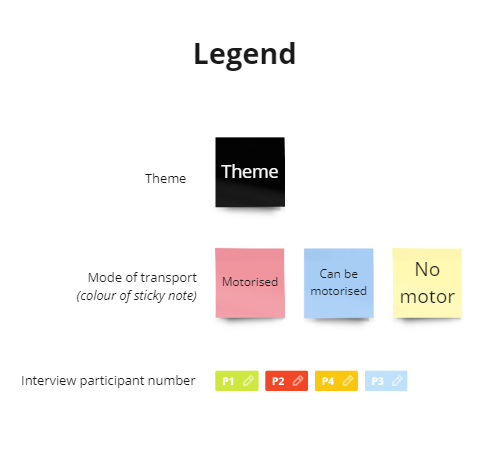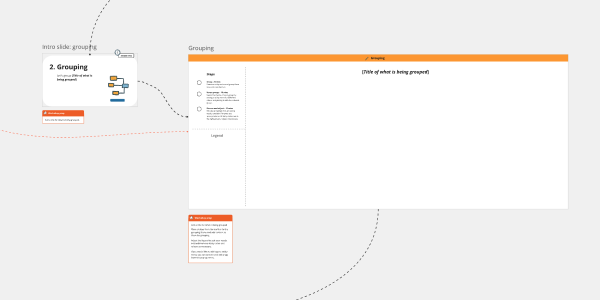Preparation
This process is about synthesising data that the team has collected - it is important to have that data ready to group. This might be ideas generated out of a brainstorming session, verbatims from customer research, or a collection of 'how might we' statements to consider thematically.
All options need to be displayed on sticky notes (or clearly described in a text box) for participants (either digital ones in Miro or paper ones, if in person). Place them near to each other if possible so they can all be seen without changing view (if possible). If you have collected ideas or insights on a Miro board, consider making a copy of the work area (Miro calls the work area a 'frame' to use for grouping to preserve your original.
You may have data from various sources that you need to identify later in the process. There are several ways to do this. For example, if you have customer verbatims from user testing interviews you should have large groups of sticky notes for each interview (one verbatim per note). Each interview or customer could be identified by having a different colour assigned to them. You can also use the 'tag' function in Miro to add multiple labels to the notes. This might include things such as interviews or participant numbers. This adds another layer of data that can be used as you group the information and make sense of it after the activity.
Don't forget to make a legend to explain your colours and tags to the participants.

The legend helps participants to distinguish between categories of data using different coloured sticky notes and tags
Invite your participants
Participants in this session could be varied. You can use Grouping with very large groups, smaller project teams or even a single person (sometimes only the project lead does this activity).
Consider which stakeholders and team members would be best placed to participate in the wider workshop if using this activity as one part of a larger session. Participants in this session should be made up of the project team and any subject matter experts relevant to the project. This might include a Project Manager (PM), Project Officer, Designer, Business Analyst, Communications Officer, Solution Architect, or Developer. You may also need to invite SMEs from policy, operational and customer service teams. Aim for including a range of people so that there is a diverse range of views.
Usually, you will include people that have been involved in the process prior to this point so that they have some background on the topic and data being grouped. You’ll want to make sure when you send an invite for the session, that you clearly explain the goal, how long it will take, and why people’s participation will be beneficial.
If grouping is part of another activity session, ensure there is enough time to incorporate it into the agenda. For example, grouping is very useful after a brainstorming activity, such as the silent brainstorm play.
It’s important to give enough notice to ensure participants have free time to come along to the session. Aim to send invitations about 2 weeks in advance.
You can also attach the play for people to look at ahead of time.
Calendar invite for grouping
Subject:
You're invited to help conduct grouping for [project name]
Meeting description:
Hi [team name if sending a group invitation, or participant name if sending individual invitations]
As part of our ongoing work for [project name], we'd like to get everyone together to identify themes within the data that we have collected so far. Grouping is an activity that allows participants to organise elements such as ideas and research findings into related groups . Using grouping to categorise data can help with identifying themes (rather than addressing each data point individually) which will enable the project team to address patterns found within the data.
In this session we’ll work together to process our data to get a better understanding about the themes for the next step in the project.
The session will take about [x] minutes and there is no preparation required.
[If conducting the workshop virtually include the following - We will be using Miro for this workshop, and you can read more about grouping in the Digital service design playbook.]
I look forward to your contribution to the session. [If you’re planning to record the session include the following - We will be recording the session for learning and development purposes and recordkeeping. Please let us know before the session if you don't want to be included in the recording or transcript].
The [project name] team is committed to inclusion for our events, and we appreciate the experience of inclusion is not the same for everyone. Please let us know what we can do to make our events more accessible and inclusive for you.
Kind regards,
[Facilitator name]
Setting up the tools
For remote teams, use the Miro template provided, or Microsoft Whiteboard.
For in-person teams, content on sticky notes should already be placed on the wall together and in view of the whole team.




